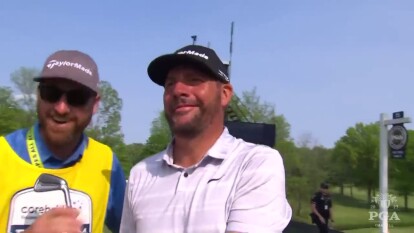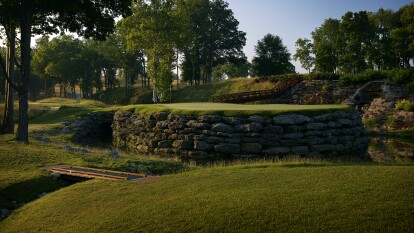Dow Finsterwald wiped the sweat off his brow, and sat at a table in front of a crowded press tent on July 20, 1958, at Llanerch Country Club in Havertown, Pennsylvania. He took the microphone and made an announcement.
“Gentlemen, you’ve got yourselves a colorless champion,” he said.
Finsterwald may not have been the marquee name golf fans were anticipating or cameras were focusing on in the PGA Championship, but he executed when it mattered. Behind opponent Sam Snead by two strokes entering the final round, he posted a 31 on the front nine for a two-stroke lead that he carried to the end.
The week was full of history for the PGA of America. For the first time, its signature championship was contested at stroke play. It also was the first PGA Championship on network television: CBS provided nationwide coverage Saturday and Sunday.
One year earlier, the 28-year-old Finsterwald, a native of Athens, Ohio, lost the PGA Championship’s final match, 2 and 1, to Lionel Hebert. Finsterwald found his form in the transition to stroke play.
“Yes, I was the one there at the end, but I didn’t dwell on it,” said Finsterwald years later.
“Those last nine holes almost felt like match play to me.”
Snead, 46, was bidding to win a fourth PGA Championship when Finsterwald stepped up. By birdieing the fourth, fifth and seventh holes, Finsterwald turned a two-shot deficit into a two-shot lead heading to the final nine.
The moment of truth for Finsterwald came on No. 12, then a 178-yard par-3 that was bordered by trees.
“I missed my tee shot badly left and was faced with hitting over a tree to a downslope,” said Finsterwald. “I got a tremendous break. I wedged my ball to 12 feet and made that putt on a green that was probably in the worst condition of the greens that week. I remember Sam three-putting.”
Finsterwald told reporters he had made a “Houdini par.” Years later, he said, “I felt only a magician could have saved par there.”
That week, Finsterwald’s father, Russ, who started his son in golf, was in the gallery. He walked the entire 72 holes along with Finsterwald’s uncle Abe.
Finsterwald won 12 times as a PGA Tour professional, along with capturing the 1957 Vardon Trophy, registering the lowest scoring average (70.3) for an entire season, and being named 1958 PGA Player of the Year. He made 72 consecutive cuts, still the fifth-longest streak all time. In fact, in his 34 years as a Tour pro, Finsterwald made 398 of 474 cuts, an amazing 83.9 percent efficiency standard.
He also was a member of four U.S. Ryder Cup teams, and served as non-playing captain for the victorious 1977 U.S. Ryder Cup Team.
Still, it was a week outside Philadelphia that proved Finsterwald’s hallmark performance. Having failed to qualify for the U.S. Open earlier in the year, Finsterwald put together rounds of 67-72-70-67 to defeat Billy Casper by two strokes and Sam Snead by four. Finsterwald earned a first-place check of $5,500.
In the 1960s, Finsterwald became a fixture for many Midwesterners watching the Chicago Cubs on WGN. His "Golf Tip of the Day" followed Cubs telecasts.
The program was a series of instructional vignettes, filmed in color in 1962, in which Finsterwald helped sports and entertainment celebrities fix their golf swings. The made-for-television films were among the first of their kind.
The first six weeks of filming took place on a golf course in New Jersey. Celebrities such as Yankees great Roger Maris and comedian Henny Youngman were among those presenting Finsterwald with their swing problems. Among his trademark lines: "We'll be back in a minute to see if this tip will help you TV viewers."
At the close of each segment, Finsterwald added a signature farewell: "If you didn't see your problem today, come back. You will."



